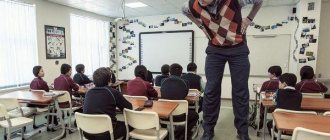Concept: briefly
What is pedagogical communication?
Communication is a key factor in the mental and social development of the individual .
Only in the process of communication with adults does a child learn norms of behavior and receive information about the world around him and about society.
The more productive the interaction with others is, the the individual’s chances for realization
Not only the immediate environment in the person of parents, relatives and friends has a huge influence on the child. Teachers also play a significant role.
Pedagogical communication is the interaction between a teacher and a student within the educational process.
This is a multi-level communication, which includes the transmission and reception of information, the occurrence of emotional reactions, and the establishment of mutual understanding . As a result of joint activities, the student acquires new knowledge.
Normative function
Regulatory. Aimed at improving the behavioral, legal, moral and aesthetic foundations of the individual. In the process of communication, students receive multifaceted moral and aesthetic information. It helps them to assimilate and develop moral concepts, norms and principles, promotes the development of social activity and ideas about the socio-legal sphere of society, teaches them how to navigate life correctly, determine the line between what is permitted and what is prohibited, and choose legally permitted (civilized) ways and means of protecting their rights, freedoms, interests. This function is based on the assimilation of legal knowledge, specific rules of law, the formation of evaluative attitudes and the legal culture of students. The normative function promotes students’ compliance with the rules of behavior at school and outside it, makes it possible to consciously and respectfully treat the laws of the state, and strengthen law and order with their attitude and behavior.
Psychological foundations
Pedagogical communication is an important factor influencing the student’s socialization and his personal development . If the interaction of the parties occurs effectively, the student acquires new skills and knowledge, and self-confidence.
The teacher, in turn, is convinced of his own professional competence and receives satisfaction from the educational process.
Negative results of interaction have a negative impact on the psychological state of both parties : the teacher may doubt his own competence, and the student may lose interest in learning.
Pedagogical communication has a triple focus: on the interaction itself (transfer of information), on students (their condition, their development), on the subject of mastery.
At the same time, the teacher must convey information to the entire audience, take into account the characteristics of each student, and focus on all the important points of the material being learned.
The process of building relationships with clients is also difficult. On the one hand, the pedagogical process involves business relationships .
On the other hand, productive results can be achieved only by creating a psychological atmosphere favorable for students. Accordingly, effective teacher activity involves a combination of business and personal relationships.
Culture of pedagogical communication
It is based on the general and pedagogical culture of the teacher’s personality .
General culture refers to the level of human development, his spiritual and moral qualities, and intellectual abilities.
The higher this indicator, the more the teacher can give to his students. Pedagogical culture is an understanding of the specifics of one’s professional activities aimed at educating the younger generation.
Each teacher has his own character, demeanor, style, etc. However, the culture of his behavior is expressed in compliance with the following rules:
- respectful attitude towards each student, regardless of personal opinion about him;
- objective assessment of students' abilities;
- taking into account the psychological characteristics of students;
- demonstrating goodwill and openness;
- interested attitude to any point of view;
- willingness to give explanations and repeat information that was not learned the first time;
- display of tolerance, understanding, participation;
- recognition of the right of wards to have their own point of view, different from the opinion of the majority;
- exclusion of any threats, ridicule, humiliation, reproaches (a negative assessment can be given to the results of study, and not specifically to the student’s personality);
- absence in the teacher’s behavior of signs of a sense of superiority due to his position or life experience.
Existing barriers to pedagogical communication
Sometimes, when organizing educational and training pedagogical processes, certain difficulties may arise in the interaction between the teacher and students. They are called barriers. They can be the causes of various conflict situations or indirectly contribute to their occurrence.
The completeness of the perception and transmission of teaching and cognitive information is often associated with the presence or absence of barriers. The culture of pedagogical communication is aimed at eliminating such situations, since with existing barriers, educational information may be distorted or not reach students at all. Therefore, it is believed that barriers are, first of all, obstacles to the transfer of knowledge. They can be communicative, associated with a misunderstanding of the speaker, or psychological, associated with reasons of a psychological nature - a negative impression, shyness.
Difficulties of pedagogical communication
During pedagogical communication between the teacher and students, certain difficulties may arise:
- Information difficulties are associated with the inability to accurately express one’s attitude towards something. Complete a thought, clarify or formulate questions that require detailed or monosyllabic answers.
- Affective. They are expressed in the inability to approve the students’ correct answers and praise them for their active work in class. Respond positively to well-formulated ideas, or show dissatisfaction with blunders or bad behavior.
- Regulatory - inability to increase student activity.
The features of pedagogical communication include the specificity of interaction between all participants in the educational or training process. The teacher builds relationships not only with students, but also with their parents, as well as with his work colleagues.
Functions
Pedagogical communication performs the following functions:
- Regulatory . Students receive information about the basic rules and norms of behavior, and develop the ability to act in accordance with the expectations of society.
- Cognitive . Gaining knowledge about the world around us, about phenomena and processes, about certain areas of science. This knowledge forms the intellectual baggage that a person has in the future.
- Emotional . During the learning process, certain emotions are formed.
- Updating . Students, in the process of acquiring knowledge, during communication with the teacher, learn their own individuality, receive opportunities for self-realization and self-expression.
- Regulatory .
The regulatory function of pedagogical communication lies in its ability to influence student behavior. The educational process involves the imposition of certain responsibilities, the use of influence and control measures.
Structure
This type of communication consists of several successive stages:
- Prognostic . During preparation for teaching activities, the teacher models the upcoming communication. He proceeds from the goals and objectives that confront him in each specific case. Also influenced by the personality of the teacher himself, the characteristics of the audience with whom he will interact. Building a forecast allows you to determine your behavior style, refresh your knowledge in a specific area, prepare visual materials if necessary, etc.
- Initial .
Meeting a new audience, building an initial dialogue with its representatives. At this moment, the parties form first impressions based on the emotional perception of the opponent. This stage largely determines the success of not only the content of the activity, but also its socio-psychological basis. In the very first moments of working with the audience, the teacher must determine how well the teaching model he has chosen matches the situation and the mood of the students. - Communication management . This is a direct process of interaction, during which the teacher implements the strategy planned at the prognostic stage. Depending on the response of the audience, an experienced teacher can adjust his behavior, adapting to a specific situation. He has a verbal impact on students, selects and uses various means of transmitting information, and maintains verbal and nonverbal contact.
- Final . Analysis of intermediate results of communication. Identification of existing problems in order to adjust the selected methods. Determination of pedagogical tasks that will be solved in the future. It is important for a teacher to be able to objectively evaluate the results of interaction and feel feedback from the audience. Otherwise, the effectiveness of communication and the educational process itself will be very low.
The structure of professional and pedagogical communication includes:
- Modeling by the teacher of upcoming communication with the class (prognostic stage).
- Organization of direct communication at the moment of initial interaction (communication attack).
- Managing communication during the pedagogical process.
- Analysis of the implemented communication system and its modeling for future activities.
modeling stage requires knowledge of the characteristics of the audience: the nature of its cognitive activity, probabilistic difficulties, and work dynamics. The material being prepared for the lesson should be mentally presented in the situation of the upcoming interaction and thought out not only on behalf of the teacher, but also on behalf of the students, if possible in different versions. At the stage called “ communicative attack ”, a technique is needed to quickly involve the class in work, it is necessary to master the techniques of self-presentation and dynamic influence. At the stage of managing communication, it is necessary to be able to support the initiative of schoolchildren, organize dialogical communication, and adjust your plan to suit real conditions. And finally, the analysis of communication is aimed at correlating goals, means and results. There are two sides to communication: attitude and interaction.
Species and types
Pedagogical communication is represented by two main types:
- Individual . A two-way dialogue in which the teacher and a specific student take part. Thus, when one student is called to the board or during a discussion at a seminar about a particular student’s report, individual communication between the teacher and the student occurs.
- Frontal . Interaction between the teacher and the entire audience at the same time. Occurs while teaching a lesson in a classroom or giving a lecture at an institute. In this case, the information is transmitted impersonally.
The teacher must be fully proficient in both types of communication, since the educational process almost always includes both.
The typology of pedagogical communication is very diverse depending on those factors that are subject to analysis:
- by direction: direct, indirect;
- by content: educational, sports, leisure activities;
- by purpose: spontaneous, purposeful;
- by controllability: uncontrollable, partially controllable, controllable;
- according to the established relationship: equality, leadership;
- by the nature of communication: cooperation, dialogue, guardianship, suppression, conflict.
- by audience coverage: private, public;
- by the presence of intentions: accidental, intentional;
- by duration: long-term, short-term;
- by effectiveness: productive, unproductive.
Leadership (interaction) styles
In modern psychological and pedagogical literature, there are various classifications of pedagogical leadership styles. Most often, three main varieties are identified: authoritarian style, democratic and liberal. A teacher who adheres to democratic tendencies in his leadership style involves students in making decisions regarding the life of the team, the nature of activities, stimulates the development of public opinion, independence, and shows interest in the experiences and personal lives of schoolchildren. the teacher of this leadership style listens to students' critical statements; his attitude toward students is positive. When interacting directly with students, he uses not so much direct as indirect forms of encouragement to action (advice, request). “He somehow structured the lesson in such a way that he himself did not stand out as a person who knew everything. No one was afraid to say something of their own, even if they were not sure that what was said would be correct”; “We always left class with a feeling of some kind of fullness of soul and, one might even say, self-respect”; “You were drawn to this teacher like a magnet after class, no matter what grade you were in. Her attitude towards you as an equal captivated any student.” A teacher with an authoritarian leadership style refers primarily to modes of interaction based on subordination. He strives for sole management of the class and establishes strict control over the fulfillment of the requirements placed on him. The main forms of interaction are orders, instructions, instructions, reprimands. An authoritarian leadership style may provide the apparent effectiveness of group activities, but it creates an extremely unfavorable psychological climate. With long-term cooperation with a teacher of an authoritarian style, students develop negative qualities - passivity, self-doubt, aggressiveness. “Our physics teacher worked with us for three years and kept us in constant fear all this time. She could give 10 - 15 deuces in a lesson. Each of them had so many that we were already counting them. The girls came out to answer the board with tears in their eyes. Naturally, there was no time for an answer. We were just tormented, and the only thought was - if only she would let me go as soon as possible. When the teacher got sick, it was a holiday for us. Of course, she gave us a lot of knowledge, and lasting knowledge, but at what cost was it given to us! I still shudder when I hear the word “physics.” A teacher with a liberal leadership style does not interfere in the children’s affairs unless absolutely necessary, and does not show much initiative in organizing certain matters. He is characterized by indecision and hesitation. Such a teacher does not strive for innovation and is wary of students’ initiative. His attitude toward students is neutral. With him, as a rule, several of the most active students stand out, who gradually take on some of his organizational functions. “We had a math teacher. She knew mathematics well, she taught it poorly, mostly we did it ourselves, of course, whoever wanted. She had many weaknesses, but we treated her condescendingly, knowing that she forgives us a lot, does not remember evil, and does not find fault with little things. Sometimes we laughed at her, but it was not offensive. The class was strong and friendly, and when something needed to be done, we managed it ourselves.” Leadership style is formed depending on a number of objective and subjective prerequisites. Objective prerequisites include: the education of the teacher, the leadership style of the school director, the development and cohesion of the teaching staff, etc.; to the subjective - the moral and emotional-volitional development of the teacher’s personality, the characteristics of his temperament, the level of aspirations expressed in a certain self-esteem, etc. The style of relationships and the nature of interactions in the process of managing the education and upbringing of children together create the style of pedagogical communication.
Teacher communication styles
Basic communication styles:
- Authoritarian. The teacher acts as a bearer of some power, which gives him authority. The learning process is built on the basis of the teacher’s existing attitudes, views and beliefs. He independently determines the strategy of action, learning goals, and subjectively evaluates the results of interaction.
This style of behavior leads to the fact that students recognize the authority of the teacher, but do not have the opportunity to express their opinions and influence the learning process.Often the personality of the teacher causes hostility, and his students experience various emotional experiences.
- Democratic . Cooperation of the parties and collective decision-making are encouraged. The teacher and students have equal rights and opportunities. With this style of communication, students have more opportunities for self-realization and feel psychological comfort during classes. The teacher establishes a trusting, respectful relationship with them. The democratic style of pedagogical communication is the most productive way of cooperation, allowing to obtain high results.
- Conniving .
The teacher demonstrates a passive position. He does not strive to engage in interaction to the extent that it is necessary to do so. This behavior is explained by an unconscious or conscious desire to relieve oneself of responsibility for the results of the interaction. All participants in communication are involved by the teacher in solving common problems. Accordingly, the results also become the result of common efforts. In terms of productivity, such interaction is inferior to the previous two types, but from the point of view of the psychological factor it is a better option than the authoritarian style.
PEDAGOGICAL COMMUNICATION: CONCEPT, FUNCTIONS, STYLES
⇐ PreviousPage 3 of 6Next ⇒Pedagogical communication is understood as professional communication between a teacher and students in and outside of class, aimed at creating a favorable psychological climate, as well as other types of psychological optimization of educational activities and relationships between teacher and student, which has certain pedagogical functions (A.A. Leontyev).
The synthesis of the main characteristics forms a pedagogical system that carries out the training and education of the individual organized by the teaching staff.
Pedagogical communication is characterized by a triple orientation (on educational interaction, on students and on the subject of study) and a triple orientation of its subjects: (personal, social and subject) (L. A. Kharaeva).
Stages of pedagogical communication:
1) modeling of upcoming pedagogical communication in the process of preparing for a lesson (prognostic stage);
2) the process of direct communication (the initial period of communication) – “communicative attack”;
3) management of communication in the pedagogical process;
4) analysis of the produced communication technology and modeling of a new one to solve another pedagogical problem.
There are also three functions of pedagogical communication.
1. Educational. This is a leading function, but at the same time it is only part of the multilateral interaction between teacher and students. It is produced in a specially organized process at any level of the education system - preschool, school, university.
2. Educating. Provides the process of moral education.
3. Facilitative. It consists of the teacher helping the student to express himself. The teacher’s interest in the student’s success, a benevolent, supportive communication atmosphere facilitate pedagogical interaction, contribute to the student’s self-actualization and his further development.
Styles of pedagogical communication
1. Authoritarian. The teacher, based on his own attitudes, determines the goals of interaction and subjectively evaluates the results of activities. This style of communication, according to N. F. Maslova, gives rise to inadequate self-esteem in students, creates neurotics, etc.
2. Democratic. This style is characterized by cooperation between participants in pedagogical interaction.
3. Conniving. This style of communication is characterized by the teacher’s desire to practically not be involved in teaching activities. This behavior of the teacher is explained by the removal of responsibility for its results. The teacher is focused on involving everyone in solving common problems. The features of this style are mutual acceptance and mutual orientation.
The most productive way of cooperation is democratic.
Education Act:
The new law on education differs quite significantly from the old one. The provisions of the Russian Federation Law “On Education” concerned mainly managerial and financial-economic relations in the field of education. The Federal Law “On Education in the Russian Federation” regulates not only these relations, but also the content of education (including establishing requirements for educational programs and standards ), and also regulates in more detail the rights and responsibilities of participants in the educational process.
In accordance with the new law, education in the Russian Federation is divided into general education, vocational education, additional education and vocational training. At the same time, general education and vocational education are implemented at several levels. In particular, general education includes:
· preschool education;
· primary general education;
· basic general education;
· secondary general education.
Thus, preschool education is now one of the levels of general education. The development of educational programs for preschool education is regulated by federal state educational standards , but is not accompanied by intermediate certifications and final certification of students .
Beginning of the form
| Federal Law of December 29, 2012 N 273-FZ (as amended on July 23, 2013) “On Education in the Russian Federation” Valid document |
| Content: |
End of form
· Chapter 1. General provisions
· Chapter 2. Education system
· Chapter 3. Persons carrying out educational activities
· Chapter 4. Students and their parents (legal representatives)
· Chapter 5. Pedagogical, managerial and other employees of organizations carrying out educational activities
· Chapter 6. Grounds for the emergence, change and termination of educational relations
· Chapter 7. General education
· Chapter 8. Professional education
· Chapter 9. Vocational training
· Chapter 10. Additional education
· Chapter 11. Features of the implementation of certain types of educational programs and education for certain categories of students
· Chapter 12. Management of the education system. State regulation of educational activities
· Chapter 13. Economic activity and financial support in the field of education
· Chapter 14. International cooperation in the field of education
· Chapter 15. Final provisions
Chapter 1. General provisions
Article 1. Subject of regulation of this Federal Law
1. The subject of regulation of this Federal Law is social relations arising in the field of education in connection with the implementation of the right to education, ensuring state guarantees of human rights and freedoms in the field of education and the creation of conditions for the realization of the right to education (hereinafter referred to as relations in the field of education).
2. This Federal Law establishes the legal, organizational and economic foundations of education in the Russian Federation, the basic principles of the state policy of the Russian Federation in the field of education, general rules for the functioning of the education system and the implementation of educational activities, and determines the legal status of participants in relations in the field of education.
Article 2. Basic concepts used in this Federal Law
For the purposes of this Federal Law, the following basic concepts apply:
1 ) education is a single purposeful process of upbringing and training, which is a socially significant benefit and is carried out in the interests of the individual, family, society and the state, as well as the totality of acquired knowledge, abilities, skills, values, experience and competence of a certain volume and complexity for the purposes of intellectual, spiritual and moral, creative, physical and (or) professional development of a person, satisfying his educational needs and interests;
2 ) education - activities aimed at personal development, creating conditions for self-determination and socialization of the student on the basis of sociocultural, spiritual and moral values and rules and norms of behavior accepted in society in the interests of the individual, family, society and the state;
3) training is a purposeful process of organizing the activities of students to master knowledge, abilities, skills and competence, gain operational experience, develop abilities, gain experience in applying knowledge in everyday life and forming motivation for students to receive education throughout their lives;
4) level of education - a completed cycle of education, characterized by a certain unified set of requirements;
5) qualification - the level of knowledge, abilities, skills and competence that characterizes readiness to perform a certain type of professional activity;
6 ) federal state educational standard (FSES) - a set of mandatory requirements for education of a certain level and (or) for a profession, specialty and area of training, approved by the federal executive body exercising the functions of developing state policy and 11) general education - type of education, which is aimed at personal development and the acquisition, in the process of mastering basic general education programs, of knowledge, abilities, skills and the formation of competencies necessary for a person’s life in society, an informed choice of profession and obtaining vocational education;
7) vocational education - a type of education that is aimed at acquiring by students, in the process of mastering basic professional educational programs, knowledge, abilities, skills and the formation of competence of a certain level and volume, allowing them to conduct professional activities in a certain field and (or) perform work in a specific profession or specialties;
 vocational training is a type of education that is aimed at students acquiring knowledge, skills, abilities and the formation of competencies necessary to perform certain labor and official functions (certain types of labor, official activities, professions);
vocational training is a type of education that is aimed at students acquiring knowledge, skills, abilities and the formation of competencies necessary to perform certain labor and official functions (certain types of labor, official activities, professions);
 additional education is a type of education that is aimed at comprehensively satisfying a person’s educational needs in intellectual, spiritual, moral, physical and (or) professional improvement and is not accompanied by an increase in the level of education; etc.
additional education is a type of education that is aimed at comprehensively satisfying a person’s educational needs in intellectual, spiritual, moral, physical and (or) professional improvement and is not accompanied by an increase in the level of education; etc.
Article 3. Basic principles of state policy and legal regulation of relations in the field of education
1. State policy and legal regulation of relations in the field of education are based on the following principles:
1) recognition of the priority of education;
2) ensuring the right of every person to education , inadmissibility of discrimination in the field of education;
3) humanistic nature of education , priority of human life and health, individual rights and freedoms, free development of the individual, education of mutual respect, hard work, citizenship, patriotism, responsibility, legal culture, respect for nature and the environment, rational use of natural resources;
4) the unity of the educational space on the territory of the Russian Federation, the protection and development of ethnocultural characteristics and traditions of the peoples of the Russian Federation in the conditions of a multinational state;
5) creation of favorable conditions for the integration of the education system of the Russian Federation with the education systems of other states on an equal and mutually beneficial basis;
6) the secular nature of education in state and municipal organizations carrying out educational activities;
7) freedom of choice to receive education according to the inclinations and needs of a person , creating conditions for the self-realization of each person, the free development of his abilities, including the right to choose forms of education, forms of training, organizations carrying out educational activities, the direction of education within the limits provided by the education system, as well as providing teaching staff with freedom to choose forms of teaching, methods of teaching and education;
 ensuring the right to education throughout life in accordance with the needs of the individual, adaptability of the education system to the level of training, developmental characteristics, abilities and interests of the person;
ensuring the right to education throughout life in accordance with the needs of the individual, adaptability of the education system to the level of training, developmental characteristics, abilities and interests of the person;
In the Russian Federation, the right of every person to education is guaranteed. The new law “On Education” came into force on September 1, 2014.
Let's repeat for the exam!!!!!!
⇐ Previous3Next ⇒








